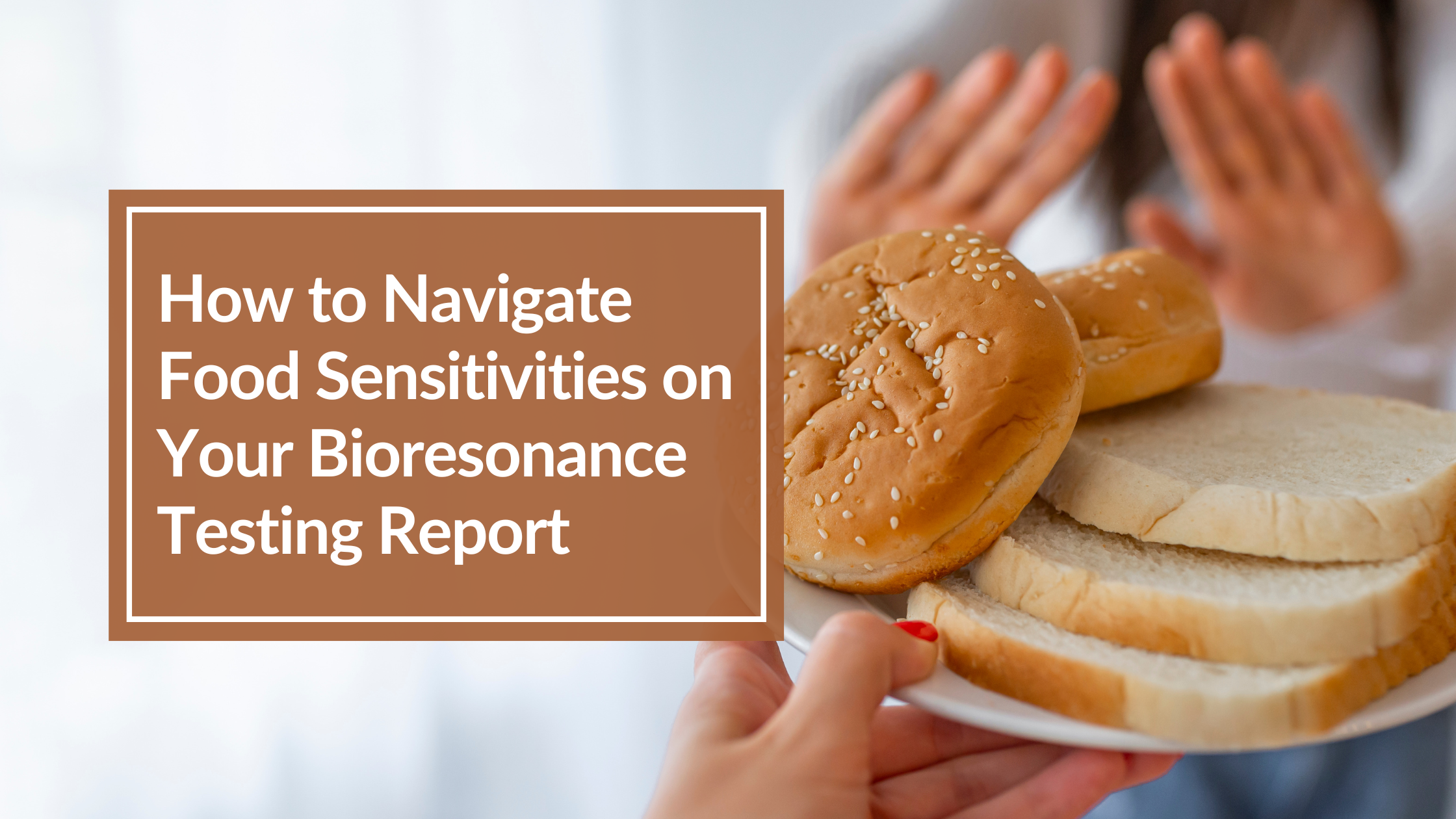
It doesn’t have to be overwhelming to navigate food sensitivities.
Trying to navigate food sensitivities on bioenergetic testing doesn’t have to be confusing. While we always recommend a 30 minute consult, we’re going to walk you through some of the subtleties of interpreting the food sensitivities on your bioenergetic testing report!
While food sensitivities can impact your health, they also significantly hamper your lifestyle, if you are not sure how to navigate your food sensitivities. You may be unsure if you even have a food sensitivity. There is a difference between food sensitivities and food allergies, as they are not the same thing.
In this article, we will explore bioenergetic testing for food sensitivities, and how to navigate them on your Full Scan Report (see a sample here).
Bioenergetic Testing to Navigate Food Sensitivities
Identifying your own specific food sensitivities can be a challenging process, as they can vary greatly from person to person. Testing methods for food sensitivities vary too.
Throw in the fact that certain foods tend to be more commonly associated with sensitivities. Gluten, dairy products, corn, eggs, soy, and peanuts are among the top culprits. These are common energetic sensitivities we see on test results. The significance of these can have nuanced interpretations with bioenergetic testing.
When you submit your hair and saliva samples for bioenergetic testing with a Full Scan, Balancing Scan, Dietary Scan or Sensitivity Scan, the samples are being tested energetically for 350 resonating sensitivities.
The sensitivities are more than just food. They include environmental sensitivities, additives, and foods, including some specific ingredients like dairy, gluten, and even saffron!
The sensitivities that are pulled into the report from your samples may reveal themselves because:
- Your Digestive System may be stressed.
- Your Nervous System may be stressed (nervous system and digestion are linked!).
- An energetic toxin may be driving the sensitivities. Think Mold or Candida!
If you find that many different foods or environmental items are resonating as sensitive, don’t despair!
We’re here to guide you while you navigate food sensitivities on bioenergetic testing!
First, let’s go over some common signs of food sensitivities.
Navigate Food Sensitivities With Common Signs
Symptoms of food sensitivities can vary from person to person.
To be honest, we see people that find their food sensitivities vary from food to food, and day to day. This is one big clue that shows you it may not be the food at all!
Some signs include:
- Digestive issues such as bloating, gas, diarrhea, or constipation.
- Headaches or migraines.
- Fatigue especially after a meal.
- Joint pain.
- Skin issues, like rashes.
- Mood swings.
These symptoms can be mild or severe, and they may occur immediately after consuming the trigger food or be delayed by several hours.
Unfortunately food sensitivities disrupt your Digestive System, leading to nutrient deficiencies and poor absorption of essential vitamins and minerals.
This could be due to the inflammation of the digestive lining, or gut mucosa. When this becomes inflamed, the tight junctions of cells may separate and cause Leaky Gut. Leaky gut may be associated with chronic conditions like IBD (irritable bowel disease), asthma, and has even been linked to Type 1 Diabetes. (1)
Chronic inflammation can also be caused by food sensitivities and can fuel the fire of other parts of the body, if they are imbalanced. There are so many bidirectional relationships between systems in the body, like the gut-brain connection.
How Do I Navigate Food Sensitivities From a Bioresonance Perspective?
If you’ve not completed a bioenergetic test yet, keeping a food diary can be helpful in pinpointing which foods trigger your symptoms. By tracking your meals and any subsequent reactions, you can start noticing patterns and identify the potential physical culprits.
If you have tested, no matter the amount of sensitivities, or kind of sensitivities that have energetically appeared, just know that most of the time, there is always an energetic link.
Food groups:
- Grains – mold, glyphosate
- Dairy – low lactase, parasites, sugar issues
- Veggies – unbalanced gut bacteria or motility,
Specific foods:
- Coffee – mold, Adrenal stress, Locomotor Stress, minerals.
- Pork – parasites, digestion.
- Peanut Butter – lipase imbalance, mycotoxins.
- Corn – aflatoxins produces by Aspergillus species, also related to alcohol and xanthan gum.

As You Navigate Food Sensitivities, Should You JUST Focus on Food?
With the amount of elimination diets that people try, you would think that the food itself, and the reaction to is, is THE cause of .food sensitivities. Yet many still struggle with digestive issues AFTER they eliminate the culprits, or what they think is the culprit.
If it’s not the food, why do your digestive issues seem to be food related?
While you can be sensitive to a food, you may have other things that are driving food sensitivities including these:
- Histamine and parasites.
- Cross reactivity or molecular mimicry.
- Leaky gut.
In fact, all three can be related.
When parasites are causing digestive stress, there is inflammation. Inflammation can trigger histamine issues. There has been a study that looked at proteins from foods that caused reactions in people and parasite proteins. There were many proteins found that were similar, and this mimicry can cause the Immune System to recognize the food as an invader, when a similar antigen is present (2)
Parasites can directly affect the gut, causing intestinal permeability, or leaky gut.
Can Diets Navigate Food Sensitivities?
Elimination diets, and alternative diets have been beneficial for some people while they navigate food sensitivities. The most well-known is the gluten-free diet, which eliminates all sources of gluten, a protein found in wheat, barley, and rye. Many try dairy, corn, and soy free diets as well.
There is also the FODMAP diet, which restricts certain types of carbohydrates that can cause digestive issues. FODMAP stands for fermentable oligosaccharides, disaccharides, monosaccharides and polyols. This type of diet has been used for those suffering from IBS or SIBO.
It is always important to consult with a healthcare professional before making any significant dietary changes.
Questions That Arise As You Navigate Food Sensitivities on Bioenergetic Test Results
Diet cola: am I energetically sensitive because of the aspartame?
Not always. If Locomotor System Stress, and mineral imbalances like phosphorus, boron or calcium, this may relate to the stress of the cola itself which may be contributing to energetic mineral imbalance.
I’m sensitive to dairy/gluten/egg, why did this not show up?
If you are sensitive to any food and avoid it, the food may not show up. With bioenergetic testing, the items that resonant are the most important to address, or avoid according to the testing. This is not the same as Western testing, that looks for antibodies in the blood.
If eggs are there, does that mean I can’t eat them anymore?
As a general rule, we suggest you eliminate the food for 30 days if possible. If eggs are a sole protein source, then this may be more difficult. We recommend you speak to a practitioner as you try to navigate food sensitivities, to come up with a plan that works.
Peanuts are on the list, but not peanut butter or peanut oil.
Peanuts are a whole food, whereas peanut butter or peanut oil are derivatives of peanuts and have undergone processing. Peanut butter has sugar and emulsifiers added to it, as well. You could almost say it was a diluted form of a peanut! Peanuts themselves also contain mycotoxins, which a processed peanut butter or oil may not.
White/Brown Rice are sensitivities, but not rice milk, rice syrup, or rice flour.
Again, the processing is different and the proteins of the food have changed.
The report shows a sensitivity to cow’s milk, but not whey, butter, yogurt, or cream.
Cow’s milk does contain a high amount of lactose, or milk sugar, whereas the other dairy products have less, along with more fat. Look for an energetic lactase imbalance when you see cow’s milk on a report.
Why are there so many meat sensitivities?
Meat can be hard to digest for anyone with stress in the Pancreas, or the Digestive System. If there is an imbalance in hydrochloric acid, protease, or if parasites resonate on a report, typically seeing an energetic sensitivity to meat may be a signal to remove the food while you are correcting a toxin imbalance.
There is also a syndrome called Alpha-Gal Syndrome, which leads people to react to red meat. This usually starts with a tick bite (3).
I’m a vegetarian, does this mean I can’t eat beans? They are a staple of my diet.
This sensitivity may be related to the amount, or kind, of gut bacteria that contributes to digestion. Any digestive stress can come from the Nervous System as well. When you are in a tressed state, you may not properly make enzymes to digest, and even move your food through the gut. Supporting digestive enzymes, with a digestive enzyme supplement, and supporting your Nervous System may help. This can be done with some simple exercises in Breathwork.
There can be many reasons why foods can show up as sensitive, and many ways to navigate food sensitivities.
Top Takeaways To Think About as You Navigate Food Sensitivities
Food sensitivities in general are complicated! They can be related to:
- Conditioned food avoidance.and body mistrust (a mind body connection to food).
- Your immune system (in the digestive system and mucous lining).
- Lack of digestive enzymes, or gut bacteria imbalance.
- Not enough chewing.
- An energetic toxin: think, parasites in the toxins list? Look for an energetic fish or pork sensitivity. Mold in the toxin list? Certain fruits, wine, or kombucha may be on the energetic sensitivity list.
These are just some of the most frequently asked questions about energetic food sensitivities on bioresonance testing. Please book a consult with one of our practitioners to dig into the deeper connections between your energetic sensitivities and your body. This way you can make a food plan that is right for you.
DISCLAIMER: Balanced Health, LLC/CBH Energetics and any parent, subsidiary, affiliated or related entities and companies do not provide medical advice or services. This post and the bioenergetic products and services offered by Balanced Health, LLC/CBH Energetics including, but not limited to, bioenergetic tests, bioenergetic scans, bioenergetic reports and related products and services (collectively the “Bioenergetic Products and Services”) are designed for educational and informational purposes only and are not intended to diagnose, treat, cure, or prevent any disease, condition, complaint, illness or medical condition and are not a substitute for professional services or medical advice. Testing is not used for the purpose of obtaining information for the diagnosis, prevention, or treatment of disease or the assessment of a health condition or for identification purposes.
